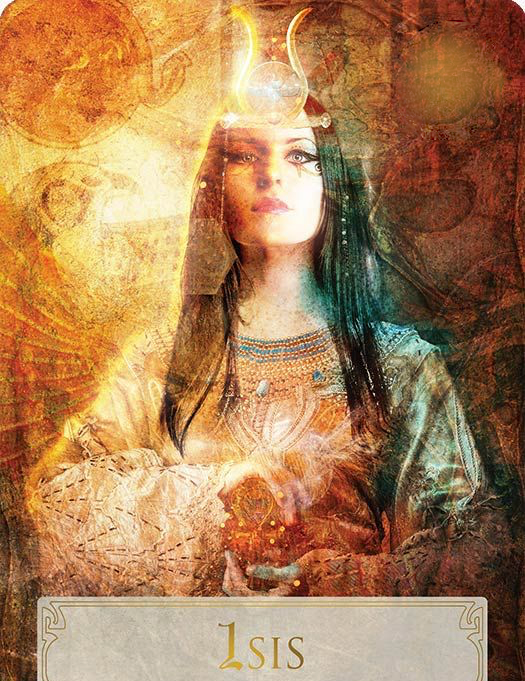Happy May Day and Blessings of Beltane to all who celebrate. In honor of that Festival of Fire, I bring you this post about Our own Lady of Holy Fire…for Isis is a fiery Goddess indeed.
Just as it does at Beltane, in ancient Egypt, fire could represent life and renewal—both very Isiac concepts, as you know.
For examples, during his rejuvenating Sed festival, the king kindled a “new” fire that symbolized his magically renewed life.
The Sun was known to be a living fire Whose birthplace and home is the Isle of Fire. The protective uraeus serpent Who coils on the brow of Re, as well as other Deities and royals, spits poisonous fire and fiery light comes forth from Her throat. Many Goddesses took the form of this fire-spitting serpent, among Them, from an early period, Isis.
The Egyptians also considered fire to be purifying and protective. In Late Period funeral rites, torches were sometimes burnt to cleanse the deceased from any earthly defilement. Flame could be used to drive off evil and exorcise demons. The justified dead could harness the power of fire to protect themselves, or they might even become a living flame themselves. They could drink from the Otherworld lakes of fire without harm, and could even be refreshed by the fiery drink. The unjustified dead, however, had reason to fear fire. They could be plunged into the lakes of fire and eternally tormented by fiery demons. Goddesses and Gods of fire threatened them and fiery gates kept them away from the path to the heavenly realms.
Isis is at Her most fiery when She is in Her aspects as Divine Protectress or as Avenging Goddess. At the entrance to the chapel of Osiris in the tomb of Seti I at Abydos, Isis is called Wosret, the Fiery One, and She protects Osiris from His enemies. At Philae, the king is shown adoring Isis in this fiery aspect; he calls Her his mother and the Lady Wosret.
In one of the hymns to Isis on the temple walls at Philae, She is Nebet Neseret, Lady (or Mistress) of Flame, and She is the fire-spitting uraeus cobra Who instantly destroys the enemies of Re with Her fire and Her potent magic. She is said to assault the rebels and to instantly slay Apophis, the enemy of Re. As the fiery uraeus of Re, She gives orders in the king’s ship.
Isis also partakes of the fiery fierceness of Sakhmet. On one of the gateways, or pylons, at Philae, She is “the mighty, the foremost of the goddesses, daughter of Geb, the sun goddess, the primeval one” and She is identified as “Sakhmet, the fiery goddess.” Yet another Philae hymn calls Her “Sakhmet, the fiery one, who destroys the enemies of her brother.” A papyrus from Oxyrhynchus praises Isis as the Lady of Light and Flames.
This fiery Isis is also connected with initiation, magic, and healing. In Plutarch’s rendition of the Isis myth, Isis nurses the child of Queen Astarte during the day, but at night magically sets the child aflame, making him immortal.
The Graeco-Egyptian magical papyri suggest an explanation for this fire magic Isis works on the queen’s son. The Charm of the Syrian Woman of Gadara says, “the most majestic Goddess’ child [Horus] was set aflame as an initiate.”
Initiation is here seen as purification by fire so that the mortal parts of the initiate are burned away, allowing her or him to more fully understand the ways of the Deities. Some scholars believe that this initiatory fire magic may have had its origins in Egyptian healing magic and what they call the “burning Horus” formula. This refers to an Egyptian convention that connects poisoning with fire. In the same way that the uraeus spits fire, when Horus is poisoned, he is also, in a sense, burned.
Burn-healing formulae identify the sufferer with Horus and say that “a fire has fallen into” Horus, that is, the sufferer. They invoke Isis to put out the fire and heal the burn. The initiatory connection may come from the fact that the poison-burned Horus experiences near-death before being healed by Isis. Mystery initiates, too, regularly undergo symbolic near-death experiences before being saved by the Goddess or God of the Mystery Rite.
Isis is Iset Wosret and the fire-spitting Cobra Goddess. She is the Mistress of Light and Flame Who slays evil and protects us all. And She is the one Who not only initiates us by fire, but also warms us by Her illuminating light.











